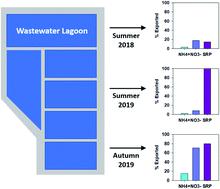当前位置:
X-MOL 学术
›
Environ. Sci.: Processes Impacts
›
论文详情
Our official English website, www.x-mol.net, welcomes your
feedback! (Note: you will need to create a separate account there.)
Fate of bioavailable nutrients released to a stream during episodic effluent releases from a municipal wastewater treatment lagoon
Environmental Science: Processes & Impacts ( IF 4.3 ) Pub Date : 2020-11-03 , DOI: 10.1039/d0em00315h Kristin J. Painter 1, 2, 3, 4 , Robert B. Brua 4, 5, 6, 7 , John Spoelstra 4, 5, 8, 9, 10 , Geoff Koehler 4, 5, 6, 7, 11 , Adam G. Yates 1, 2, 3, 4
Environmental Science: Processes & Impacts ( IF 4.3 ) Pub Date : 2020-11-03 , DOI: 10.1039/d0em00315h Kristin J. Painter 1, 2, 3, 4 , Robert B. Brua 4, 5, 6, 7 , John Spoelstra 4, 5, 8, 9, 10 , Geoff Koehler 4, 5, 6, 7, 11 , Adam G. Yates 1, 2, 3, 4
Affiliation

|
Municipal wastewater lagoons are common across North America and, unlike larger mechanical wastewater treatment plants, typically release nutrient-rich effluent directly to rivers in intermittent pulses. However, little is known about the fate of nutrients from these episodic events, which may happen under varying hydrologic or thermal conditions. We assessed fate of nitrogen (N) and phosphorus (P) from lagoon effluent during three releases to Deadhorse Creek, Manitoba, Canada. Using net nutrient uptake lengths and natural abundance stable isotope ratios of dissolved inorganic nitrogen (DIN) and primary producers, we found that DIN was processed during the summer releases though the dominant mechanism was unclear. However, nitrate was largely exported in autumn. Primary producers assimilated lagoon N but did not appear to reduce DIN concentrations. The longitudinal pattern of soluble reactive phosphorus (SRP) varied between releases and in summer 2019 the stream became a net source of SRP despite concomitant processing of DIN. We hypothesize that low demand for P in Deadhorse Creek, as suggested by upstream SRP > 0.05 mg P L−1, and nutrient ratios indicative of N limitation, reduced instream processing of P. Furthermore, our results indicated that cool or high flow conditions may result in the export of much of the lagoon nutrient load downstream. Our findings suggest the processes that transform wastewater nutrients are overwhelmed during effluent releases. Managers should consider increasing effluent dilution via continuous release of effluent rather than pulsed delivery. However, management of upstream nutrient supply may also be needed when relying upon the self-purifying capacity of rivers.
中文翻译:

在市政废水处理泻湖的间歇性污水排放过程中,释放到河流中的生物利用养分的命运
在北美,市政污水池很常见,与大型机械废水处理厂不同,污水池通常会间歇性地将富含营养的污水直接排放到河流中。但是,对于这些偶然事件中营养物的命运知之甚少,这些事件可能在变化的水文条件或热条件下发生。我们评估了在向加拿大马尼托巴省Deadhorse Creek的三次排放过程中,泻湖废水中氮(N)和磷(P)的命运。使用净养分吸收长度和溶解无机氮(DIN)和主要生产者的自然丰度稳定同位素比,我们发现在夏季释放期间对DIN进行了处理,尽管其主要机理尚不清楚。但是,硝酸盐在秋季大量出口。初级生产者吸收了泻湖N,但似乎没有降低DIN浓度。可溶性反应性磷(SRP)的纵向模式在释放之间有所不同,并且在2019年夏季,尽管同时进行了DIN处理,但该流却成为SRP的净来源。我们推测,如上游SRP> 0.05 mg PL所示,Deadhorse Creek对磷的需求较低。-1和表示N限制的养分比减少了P的上游加工。此外,我们的结果表明,凉爽或高流量的条件可能导致下游大量泻湖养分负荷的输出。我们的发现表明,在废水释放过程中,转化废水养分的过程不胜枚举。管理人员应考虑通过连续释放废水而不是脉冲输送来增加废水稀释度。但是,当依靠河流的自净能力时,也可能需要管理上游养分供应。
更新日期:2020-11-06
中文翻译:

在市政废水处理泻湖的间歇性污水排放过程中,释放到河流中的生物利用养分的命运
在北美,市政污水池很常见,与大型机械废水处理厂不同,污水池通常会间歇性地将富含营养的污水直接排放到河流中。但是,对于这些偶然事件中营养物的命运知之甚少,这些事件可能在变化的水文条件或热条件下发生。我们评估了在向加拿大马尼托巴省Deadhorse Creek的三次排放过程中,泻湖废水中氮(N)和磷(P)的命运。使用净养分吸收长度和溶解无机氮(DIN)和主要生产者的自然丰度稳定同位素比,我们发现在夏季释放期间对DIN进行了处理,尽管其主要机理尚不清楚。但是,硝酸盐在秋季大量出口。初级生产者吸收了泻湖N,但似乎没有降低DIN浓度。可溶性反应性磷(SRP)的纵向模式在释放之间有所不同,并且在2019年夏季,尽管同时进行了DIN处理,但该流却成为SRP的净来源。我们推测,如上游SRP> 0.05 mg PL所示,Deadhorse Creek对磷的需求较低。-1和表示N限制的养分比减少了P的上游加工。此外,我们的结果表明,凉爽或高流量的条件可能导致下游大量泻湖养分负荷的输出。我们的发现表明,在废水释放过程中,转化废水养分的过程不胜枚举。管理人员应考虑通过连续释放废水而不是脉冲输送来增加废水稀释度。但是,当依靠河流的自净能力时,也可能需要管理上游养分供应。











































 京公网安备 11010802027423号
京公网安备 11010802027423号